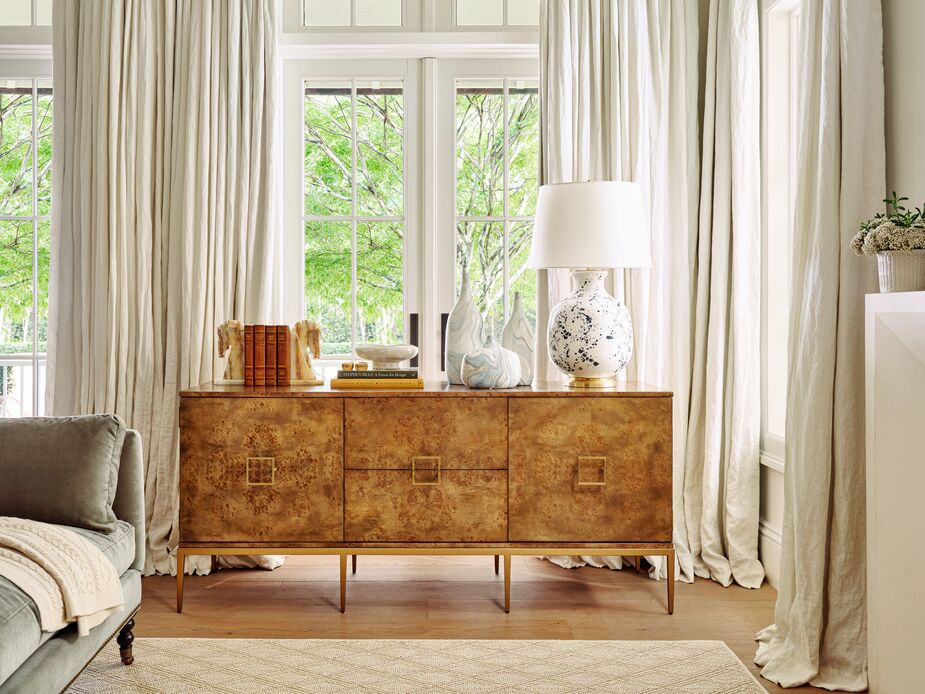Burl wood and plaster wouldn’t seem to have much in common. One is a happy accident of nature, the other a manmade composition that’s been refined over millennia. But both materials have become increasingly popular with designers and tastemakers, and both are timelessly chic.

Burl wood and plasterlike finishes complement each other impeccably. Above: Chloe Coffee Table, Scarlett Resin Wall Mirror, Benit Medium Sculpted Chandelier in Plaster White, Carlin Side Table, and Diana Vase. Find the rug here.
The Beauty of Burl
Burl wood is a tree deformity, sort of like a callus (when the result of injury to the trunk) or a tumor. For centuries, most woodworkers tossed aside any burls on lumber. The irregular swirls and pitting that give burl its distinctive appearance make it difficult to work with. And burl wood’s irregularities were at odds with society’s concepts of beauty, which emphasized perfection.
The makers of Biedermeier furniture in 19th-century Germany were among the first to popularize the beauty of burl wood’s imperfections. But appreciation of the material really became widespread in the early 20th century. Burl’s extravagant, unpredictable patterns and color variances fit right in with the anything-goes, rules-are-made-for-breaking, more-is-more 1920s. Another reason for burl’s appeal: Its relative scarcity made the material a status symbol. And so burl became an in-demand feature of Art Deco furnishings, usually in the form of veneers. (Burl wood isn’t suited for furniture construction.)
Burl wood began fading in popularity at the end of the 1970s. Was it a coincidence that the acceptance of nonconformity also ebbed to a degree at that time? That’s a question for sociologists, not us. We’re just delighted that another generation is appreciating the beauty of burl’s idiosyncracies.
The Pleasures of Plaster
Plaster dates back to ancient Mesopotamia. Of course, the plaster used in the construction of the Egyptian pyramids differs somewhat from the plaster with which the ancient Romans decorated their baths, the plaster doctors use when making casts, and the plaster used for pottery. Some people consider stucco and gesso types of plasters, further confusing things. For our purposes, though, we’ll consider plaster a pale powder such as lime or gypsum combined with water to create a solid that can be molded, sculptured, and otherwise manipulated until it is hardened. Then again, many furnishings that look like plaster, from lamps to sculptures, aren’t made with plaster at all but rather more durable and affordable materials such as resin or concrete.
Color can be added to plaster before it dries, but it’s the powdery white hue that is most popular today. Likewise, plaster can be made impeccably smooth, but currently a somewhat irregular texture is in vogue. As with burl, it’s the imperfections that appeal, providing a warmer, more artisanal counterpoint to sleek, glossy, machine-made surfaces. Plaster and burl are celebrations of the unique, making them ideal additions to a home designed to reflect your unique style.
Shop our Material Mix edit >

“Plaster is the perfect material for creating naturalistic forms,” says Julie Neill, who designed the Alberto Medium Two-Tier Chandelier, shown here in Plaster White, for Visual Comfort. Photo by Read McKendree.

The white plasterlike finish of the chandelier (find a similar one here) complements rather than detracts from the burl top of the Tranquility Extension Dining Table. This particular type of burl, mappa, comes from European poplar trees. Find the dining chairs here.
Five Favorite Burl Pieces
• Montclair Demilune Console. The burl of olive ash trees (ash trees whose inner wood resembles that of olive trees) is much sought after, and this demilune table shows why.
• Mora Burl Wood Buffet. This buffet’s unadorned surfaces and simple shape allow the dramatic clusters of the oak burl to take center stage. In addition to making a lavish style statement, this piece is quite versatile, with shelves and cord cutouts behind its doors.
• Madison Table Lamp. This lamp’s body is made up of lacquered cylinders of burl connected by slender acrylic discs, giving the time-honored wood a contemporary gloss.
• Orwell Wall Mirror. Bunny Williams gave this mirror’s burl-wood frame slender borders, almost like piping, of ebony and off-white tiles. The result is one of matter-of-fact luxuriousness.
• Madison Burl End Table. This handcrafted side table allows you to relish the beauty of burl without breaking the bank. Tapered legs and brass ferrules add to its quiet but undeniable glamour.
Five Favorite Plaster Pieces
• Wind 1 and Wind 2. Using plaster and silk, artist Dawn Wolfe created a pair of otherworldly bas reliefs.
• Tranquility Enlightenment Side Table. Reminiscent of homemade marshmallows, this table complements its billowy curves with a gently irregular texture.
• Jane Petal Table Lamp in Plaster White. This lamp is also available in gold and silver, but we think the white finish best accentuates the whimsy of the design.
• Monolith Outdoor Dining Table. With its raw-edge top, sleek pedestal base, and soft white finish, this round dining table works beautifully indoors or out.
• Straight Straight Happy Happy 40 Vase in White. This hand-thrown ceramic vase was fired at a particular temperature to achieve its distinctive plasterlike finish.
Your style, our expertise: Book a free appointment from One Kings Lane Interior Design >

The plaster sculptures of Albert Giacometti inspired the Astor Wall Mirror and the Astor Table Lamp. Find a similar tabletop sculpture here.

Join the Discussion